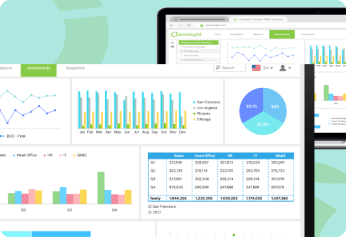Picture this: Your company just landed a major client, but you're not sure if your current team can handle the increased workload. Or perhaps economic uncertainty has you questioning whether your staffing levels align with realistic revenue projections. These scenarios highlight why headcount planning isn't just an HR exercise-it's a strategic business imperative that directly impacts your bottom line.
Headcount planning is the systematic process of determining the optimal number and types of employees needed to achieve business objectives while managing costs effectively. This glossary will walk you through everything you need to know about headcount planning, from fundamental concepts to advanced strategies that growing organizations use to scale successfully.
What is Headcount Planning?
Headcount planning is the strategic process of forecasting, budgeting, and managing an organization's workforce needs to align with business goals and financial constraints. Think of it as creating a roadmap that shows when, where, and what types of employees you'll need to hire, retain, or potentially reduce to meet your organization's objectives.
Unlike reactive hiring—where you scramble to fill positions after someone quits or when workload suddenly increases—headcount planning takes a proactive approach. It considers factors like seasonal fluctuations, business growth projections, skill requirements, and budget limitations to create a workforce strategy that supports sustainable growth.
Key Concepts in Headcount Planning
Forecasting
Forecasting in headcount planning involves predicting future workforce needs based on business projections, historical data, and market trends. This isn't about making wild guesses—it's about using data to make informed predictions about when you'll need to expand teams, what skills will be in demand, and how external factors might impact your staffing requirements.
Effective forecasting considers multiple scenarios: best case (rapid growth), worst case (economic downturn), and most likely case (steady growth). This approach helps organizations prepare for various outcomes rather than betting everything on a single prediction.
Budgeting
Budgeting connects your workforce plans to financial reality. It's one thing to say you need five new software engineers; it's another to calculate the total cost of those hires, including salaries, benefits, equipment, training, and office space.
Headcount budgeting goes beyond just salary costs. Smart finance teams factor in the full cost of employment, which can be 1.25 to 1.4 times the base salary when you include benefits, taxes, equipment, and overhead costs.
Alignment with Business Strategy
Your headcount plan should directly support your business strategy, not exist in isolation. If your company is launching a new product line, your headcount plan should reflect the skills and roles needed to make that launch successful. If you're expanding into new markets, you'll need to plan for local hiring or remote workforce expansion.
This alignment ensures that every hire contributes to strategic objectives rather than just filling immediate gaps. It transforms headcount planning from a reactive cost center into a proactive growth enabler.
Importance of Headcount Planning
Business Efficiency
Proper headcount planning eliminates the costly cycle of panic hiring and subsequent layoffs. When you plan ahead, you can recruit more selectively, leading to better hires who stay longer and contribute more effectively. You also avoid the productivity losses that come from being understaffed or the waste that comes from being overstaffed.
Consider the real cost of poor planning: A rushed hire might cost 30% more in recruitment fees, take longer to become productive, and have a higher likelihood of leaving within the first year. Meanwhile, being understaffed can lead to employee burnout, missed opportunities, and customer dissatisfaction.
Talent Acquisition and Retention
In today's competitive talent market, good candidates often have multiple options. Organizations with clear headcount plans can move faster in the hiring process, make competitive offers, and provide candidates with clarity about career progression opportunities.
Headcount planning also supports retention by helping you identify skill gaps before they become critical. This allows you to invest in training and development for existing employees, showing them a clear path for growth within your organization.
Risk Management
Headcount planning helps identify and mitigate workforce-related risks before they impact your business. These risks might include:
- Key person dependency (what happens if your lead developer quits?)
- Skills gaps that could prevent you from delivering on client commitments
- Regulatory compliance issues in industries with specific staffing requirements
- Cash flow problems caused by unplanned hiring sprees
By thinking through these scenarios in advance, you can develop contingency plans and build resilience into your workforce strategy.
The Headcount Planning Process
Data Collection and Analysis
Step 1: Gather historical workforce data including hiring patterns, turnover rates, performance metrics, and cost per hire.
Step 2: Collect business data such as revenue projections, planned product launches, market expansion goals, and seasonal patterns.
Step 3: Analyze external factors including industry trends, labor market conditions, and regulatory changes that might impact your workforce needs.
Step 4: Review current workforce capabilities, identifying strengths, gaps, and areas where skills might become obsolete.
The quality of your headcount plan depends heavily on the quality of your data. Many organizations discover they lack basic workforce analytics when they start this process. If that's your situation, start collecting this data now—even simple spreadsheet tracking is better than nothing.
Goal Setting
Step 1: Define specific, measurable objectives that align with your business strategy.
Step 2: Set realistic timelines that account for recruitment lead times and onboarding periods.
Step 3: Establish budget parameters that balance growth ambitions with financial constraints.
Step 4: Create accountability measures to track progress and adjust plans as needed.
Good goals in headcount planning are specific and tied to business outcomes. Instead of "hire more salespeople," a better goal would be "hire three enterprise sales representatives by Q2 to support our expansion into the healthcare vertical, with a target of $2M in new revenue within their first year."
Implementation and Monitoring
Step 1: Create detailed hiring timelines that work backward from when you need people to be productive.
Step 2: Establish approval processes that balance speed with oversight.
Step 3: Set up regular review cycles to assess progress and make adjustments.
Step 4: Track key metrics such as time-to-fill, cost-per-hire, and new hire productivity.
Implementation is where many headcount plans fall apart. The key is building flexibility into your plan while maintaining accountability for results. Regular check-ins help you spot problems early and adjust course before small issues become major problems.
Challenges in Headcount Planning
Common Pitfalls
- Overreliance on Historical Data: Past performance doesn't always predict future needs, especially in rapidly changing markets or for growing companies.
- Ignoring Lead Times: Many organizations underestimate how long it takes to find, hire, and onboard new employees, leading to gaps in coverage.
- Failing to Account for Attrition: Not planning for normal turnover can leave you constantly playing catch-up.
- Siloed Planning: When departments plan in isolation, you might end up competing for the same talent or duplicating efforts.
- Budget vs. Reality Misalignment: Creating plans that look good on paper but don't account for market realities in compensation or availability of talent.
Strategies to Overcome Challenges
- Start with scenario planning rather than single-point forecasts. Create best-case, worst-case, and most-likely scenarios to prepare for different outcomes.
- Build buffer time into your hiring timelines. If you typically need 60 days to fill a role, plan for 75-90 days to account for unexpected delays.
- Develop internal talent pipelines through training and development programs. This reduces your dependence on external hiring for critical roles.
- Implement cross-functional planning sessions where different departments share their workforce needs and identify potential synergies or conflicts.
- Regularly benchmark your compensation and benefits against market rates to ensure your budget assumptions are realistic.
Tools and Best Practices for Headcount Planning
Recommended Tools
|
Tool Type |
Purpose |
Examples |
|
Workforce Analytics |
Track hiring patterns, turnover, and productivity |
BambooHR, Workday, ADP |
|
Financial Planning |
Model costs and budget scenarios |
Excel, Google Sheets, Limelight |
|
Project Management |
Track hiring progress and timelines |
Asana, Monday.com, Trello |
|
Applicant Tracking |
Manage recruitment pipeline |
Greenhouse, Lever, JazzHR |
The right tool depends on your organization's size, complexity, and existing technology stack. Many successful companies start with enhanced spreadsheet models before investing in specialized software.
Best Practices
- Start Simple: Begin with basic forecasting models and add complexity as your planning matures.
- Plan in Quarters: Annual plans are too rigid; monthly plans are too granular. Quarterly planning strikes the right balance.
- Include Multiple Stakeholders: Get input from department heads, finance, HR, and executive leadership.
- Document Assumptions: Record the reasoning behind your projections so you can evaluate and improve your process over time.
- Plan for Flexibility: Build contingency scenarios into your plans rather than creating rigid hiring schedules.
- Regular Reviews: Schedule monthly or quarterly reviews to assess progress and make adjustments.
- Focus on Business Impact: Always connect headcount decisions to business outcomes rather than just filling seats.
Streamline Your Headcount Planning with Modern FP&A Tools
While spreadsheets have long been the go-to tool for headcount planning, growing organizations often find themselves spending more time managing formulas and versions than actually planning. This is where modern financial planning and analysis (FP&A) platforms can make a significant difference. Limelight offers workforce planning capabilities that integrate seamlessly with your existing financial models, eliminating the need to maintain separate headcount spreadsheets. With pre-built templates and intuitive modeling tools, finance teams can create sophisticated headcount plans that automatically update with changes to business assumptions—turning what used to be a weeks-long spreadsheet exercise into a streamlined process. Ready to transform your headcount planning? Book a demo today and see Limelight in action.
FAQs on Headcount Planning
Q: How far in advance should we plan our headcount?
A: Most organizations benefit from 12-18 month headcount plans with quarterly updates. This provides enough runway to make strategic hires while maintaining flexibility for unexpected changes.
Q: What's the difference between headcount planning and workforce planning?
A: Headcount planning focuses on the number and timing of hires. Workforce planning is broader, including skills development, succession planning, and organizational design. Headcount planning is a subset of workforce planning.
Q: How do we handle headcount planning during uncertain economic times?
A: Create multiple scenarios with different assumptions about business growth. Focus on hiring for critical roles while building flexibility to scale up or down based on actual business performance.
Q: Should startups do formal headcount planning?
A: Even early-stage companies benefit from basic headcount planning. It doesn't need to be complex—a simple model showing when you'll need key hires and how much they'll cost can prevent cash flow problems and ensure you're building the right team for growth.
Q: How do we account for remote work in headcount planning?
A: Remote work expands your talent pool but may require different compensation strategies and management approaches. Factor in any geographic pay differences and additional tools or training needed for remote employees.
Table of Contents
Ready to put an end to outdated FP&A?
Get a perzonalized demo


